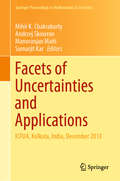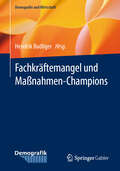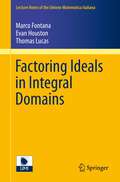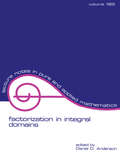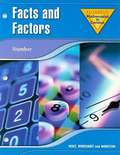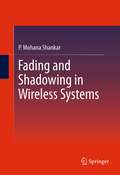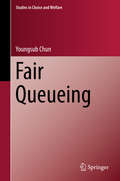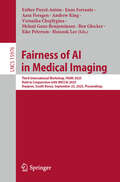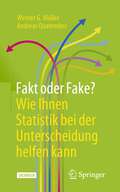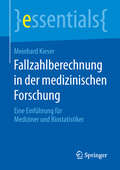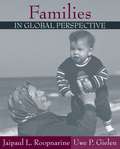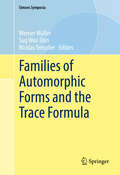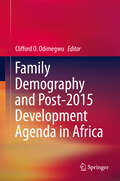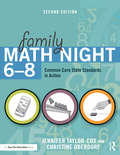- Table View
- List View
Facets of Uncertainties and Applications
by Andrzej Skowron Mihir K. Chakraborty Manoranjan Maiti Samarjit KarSince the emergence of the formal concept of probability theory in the seventeenth century, uncertainty has been perceived solely in terms of probability theory. However, this apparently unique link between uncertainty and probability theory has come under investigation a few decades back. Uncertainties are nowadays accepted to be of various kinds. Uncertainty in general could refer to different sense like not certainly known, questionable, problematic, vague, not definite or determined, ambiguous, liable to change, not reliable. In Indian languages, particularly in Sanskrit-based languages, there are other higher levels of uncertainties. It has been shown that several mathematical concepts such as the theory of fuzzy sets, theory of rough sets, evidence theory, possibility theory, theory of complex systems and complex network, theory of fuzzy measures and uncertainty theory can also successfully model uncertainty.
Fachdidaktischverbindendes Forschen und Lehren in der Mathematiklehrer*innenbildung: Neue Perspektiven auf das Lehren und Lernen von Mathematik (und Physik) (MINTUS – Beiträge zur mathematisch-naturwissenschaftlichen Bildung)
by Kathrin HoltenDas generelle Forschungsinteresse der vorliegenden Dissertationsschrift, mit einem besonderen Schwerpunkt auf die Lehrerbildung, orientiert sich am Siegener mathematikdidaktischen Forschungsparadigma empirischer Theorien im Mathematikunterricht. Ziel ist die Entwicklung und Anwendung eines Konzepts zur Eröffnung verschiedener fachdidaktischer Perspektiven aus Mathematik- und Physikdidaktik auf das Lehren und Lernen von Mathematik. Entsprechend wird eine Arbeitsdefinition des sog. fachdidaktischverbindenden Forschens und Lehrens theoretisch entwickelt und dann empirisch erprobt. Eine dazu entwickelte Lehrveranstaltung ermöglicht es den Studierenden, Chancen und Herausforderungen der Thematisierung physikalischer Kontexte im Mathematikunterricht zu identifizieren und einzuschätzen, indem sie eine entsprechende Unterrichtsstunde planen, durchführen und analysieren. Die im Seminar auftretenden Reflexionsphasen liefern die wesentliche Datenbasis zur Konstruktion einer Grounded Theory über fachdidaktischverbindendes Forschen und Lehren.
Fachkräftemangel und Maßnahmen-Champions (Demografie und Wirtschaft)
by Hendrik BudligerDer demografische Wandel stellt die Unternehmen vor große Herausforderungen. Neben strukturellen, zyklischen und unternehmensinternen Zusammenhängen ist er eine der Kernursachen für den zunehmenden Mangel an Arbeitskräften, insbesondere an gut ausgebildeten Fachkräften. Dieses Herausgeberwerk gibt einen Einblick in den aktuellen Fachkräftemangel und zeitgleich stellen Maßnahmen-Champions vor, wie sie in ihren Organisationen erfolgreiche Konzepte gegen den Fachkräftemangel umgesetzt haben. Die Leserinnen und Leser sollen von der Vielfalt der beschriebenen Maßnahmen gegen den Fachkräftemangel Ideen und Anregungen erhalten, um selbst in ihrer Organisation dem Fachkräftemangel entgegenzuwirken. Der Inhalt Grundzüge und Konzepte einer Organisationsdemografie Generationenmanagement – Theorie und Praxis Förderung der Arbeitsmarktfähigkeit und Arbeitsfähigkeit Gelebte HR-Strategie im Change-Prozess Digitales Workforce-Management HR Analytics als strategisches Instrument Maßnahmen gegen den Fachkräftemangel: Senior Talents fördern, Vereinbarkeit Familie und Beruf, Integration von Arbeitskräften aus Drittstaaten Praxisbeiträge aus Baugewerbe, Hotelbranche und Tech-Industrie
Facility Location Under Uncertainty: Models, Algorithms and Applications (International Series in Operations Research & Management Science #356)
by Shuming Wang Francisco Saldanha-da-GamaThis textbook provides researchers, post-graduate students, and practitioners with a systematic framework for coping with uncertainty when making facility location decisions. In addition to in-depth coverage of models and solution techniques, application areas are discussed. The book guides readers through the field, showing how to successfully analyze new problems and handle new applications. Initially, the focus is on base models and concepts. Then, gradually, more comprehensive models and more involved solution algorithms are discussed. Throughout the book, two perspectives are intertwined: the paradigm for capturing uncertainty, and the facility location problem at hand. The former includes stochastic programming, robust optimization, chance-constrained programming, and distributional robust optimization; the latter includes classical facility location problems and those arising in many real-world applications such as hub location, location routing, andlocation inventory.
Factfulness Illustrated: Ten Reasons We're Wrong About the World - Why Things are Better than You Think
by Hans Rosling Ola Rosling Anna Rosling RönnlundThe international best-selling phenomenon loved by BARACK OBAMA and BILL GATES in a new and updated illustrated edition'A hopeful book about the potential for human progress when we work off facts rather than our inherent biases.' BARACK OBAMA'One of the most important books I've ever read - an indispensable guide to thinking clearly about the world.' BILL GATES*#1 Sunday Times bestseller * instant New York Times bestseller * Observer 'best brainy book of the decade' * #1 Wall Street Journal bestseller * Irish Times bestseller * Audio bestseller * Guardian bestseller * FACTFULNESS: the stress-reducing habit of only having opinions for which there are strong supporting facts.Things aren't as bad as we think. Fact.When asked simple questions about global trends - why the world's population is increasing; how many young women go to school; how many of us live in poverty - we systematically get the answers wrong. So wrong that a chimpanzee choosing answers at random will consistently outguess journalists, Nobel laureates, and investment bankers.In Factfulness, legendary statisticians Hans, Anna and Ola Rosling offer a radical new explanation of why this happens, and reveal the ten instincts that distort our perspective. It turns out that the world, for all its imperfections, is in a much better state than we might think. But when we let the bad news take on outsize proportions instead of embracing a worldview based on facts, we can lose our ability to focus on the things that threaten us most. Inspiring and revelatory, filled with lively anecdotes and moving stories, Factfulness is an urgent and essential book that will change the way you see the world.
Factor Analysis: Classic Edition (Psychology Press & Routledge Classic Editions)
by Richard L. GorsuchComprehensive and comprehensible, this classic text covers the basic and advanced topics essential for using factor analysis as a scientific tool in psychology, education, sociology, and related areas. Emphasizing the usefulness of the techniques, it presents sufficient mathematical background for understanding and applying its use. This includes the theory as well as the empirical evaluations. The overall goal is to show readers how to use factor analysis in their substantive research by highlighting when the differences in mathematical procedures have a major impact on the substantive conclusions, when the differences are not relevant, and when factor analysis might not be the best procedure to use. Although the original version was written years ago, the book maintains its relevance today by providing readers with a thorough understanding of the basic mathematical models so they can easily apply these models to their own research. Readers are presented with a very complete picture of the "inner workings" of these methods. The new Introduction highlights the remarkably few changes that the author would make if he were writing the book today. An ideal text for courses on factor analysis or as a supplement for multivariate analysis, structural equation modeling, or advanced quantitative techniques taught in psychology, education, and other social and behavioral sciences, researchers who use these techniques also appreciate this book’s thorough review of the basic models. Prerequisites include a graduate level course on statistics and a basic understanding of algebra. Sections with an asterisk can be skipped entirely if preferred.
Factor Analysis at 100: Historical Developments and Future Directions
by Robert C. MacCallum Robert CudeckFactor analysis is one of the success stories of statistics in the social sciences. The reason for its wide appeal is that it provides a way to investigate latent variables, the fundamental traits and concepts in the study of individual differences. Because of its importance, a conference was held to mark the centennial of the publication of Charle
Factoring Ideals in Integral Domains
by Evan Houston Marco Fontana Thomas LucasThis volume provides a wide-ranging survey of, and many new results on, various important types of ideal factorization actively investigated by several authors in recent years. Examples of domains studied include (1) those with weak factorization, in which each nonzero, nondivisorial ideal can be factored as the product of its divisorial closure and a product of maximal ideals and (2) those with pseudo-Dedekind factorization, in which each nonzero, noninvertible ideal can be factored as the product of an invertible ideal with a product of pairwise comaximal prime ideals. Prüfer domains play a central role in our study, but many non-Prüfer examples are considered as well.
Factorization in Integral Domains (Lecture Notes In Pure And Applied Mathematics Ser. #189)
by Daniel AndersonThe contents in this work are taken from both the University of Iowa's Conference on Factorization in Integral Domains, and the 909th Meeting of the American Mathematical Society's Special Session in Commutative Ring Theory held in Iowa City. The text gathers current work on factorization in integral domains and monoids, and the theory of divisibility, emphasizing possible different lengths of factorization into irreducible elements.
Factorization: Unique and Otherwise
by Steven H. WeintraubThe concept of factorization, familiar in the ordinary system of whole numbers that can be written as a unique product of prime numbers, plays a central role in modern mathematics and its applications. This exposition of the classic theory leads the reader to an understanding of the current knowledge of the subject and its connections to other math
Facts and Factors (Mathematics in Context)
by Meike Abels Jan De Lange Margaret A. PliggeThe numbers we use today are widely used by people all over the world. This might surprise you since there are about 190 independent countries in the world, speaking over 5,000 different languages! This was not always the case. In the unit Facts and Factors, you will investigate how ancient civilizations wrote numbers and performed number computations.
Fading and Shadowing in Wireless Systems
by P. Mohana ShankarThe study of signal transmission and deterioration in signal characteristics as the signal propagates through wireless channels is of great significance. The book presents a comprehensive view of channel degradation arising from fading and shadowing. Various statistical models including simple, hybrid, compound, complex and cascaded ones are presented with detailed derivations along with measures to quantify the deterioration such as the amount of fading, error rates and outage probabilities. The models range from the Rayleigh and Rician through Suzuki, generalized K, cascaded and alpha-mu and similar ones. This is followed by the analysis of mitigation of fading and shadowing through diversity (simple, hybrid, micro- and macro- level) and combining algorithms. The density and distribution functions, error rates and outages are derived and results analyzed to quantify the improvements. The effects of co-channel interference before and after the implementation of diversity are also analyzed. To facilitate easy understanding of the models and analysis, the background information in terms of probability and random variables is presented with relevant derivations of densities of linear and nonlinear transformation of random variables, the sums, products, ratios as well as order statistics of random variables of all types. The book also provides material on digital modems of interest in wireless systems. Thus, the book with 1100+ equations and 350+ Matlab generated figures and tables is an ideal source for students, educators, researchers and professionals in wireless communications allowing access to information currently unavailable.
Fair Queueing
by Youngsub ChunThis monograph provides a detailed analysis on fair queueing rules from a normative, a strategic, and a non-cooperative viewpoint. The queueing problem is concerned with the following situation: There is a group of agents who must be served in a facility. The facility can handle only one agent at a time and agents incur waiting costs. The problem is to find the order in which to serve agents and monetary transfers they should receive. The queueing problem has been studied extensively in the recent literature.
Fair Share: 111 Problems from Ahmes to Aumann
by Isaac ElishakoffKofi Annan, former Secretary General of the United Nations, argued that “We need to create a world that is equitable, that is stable and a world where we bear in mind the needs of others, and not only what we need immediately. We are all in the same boat.”American businessman, John Landgraf stated: “I hope that most of us believe that we actually would all benefit from living in a more equitable society. If that's not happening, we're squandering human potential.” For the world to be fair, one needs to know how to divide. Without the mathematics of division, humankind cannot function…Marie Antoinette, Queen of France (infamously) said “If people have no bread, let them eat cake,” and while Ahmes ― the scribe of the Rhind Mathematical Papyrus ― dealt with loaves of bread, prosperous people in the twentieth century dealt with cake division, although bread is also uniformly available. You’ll be surprised, but there are at least four books and over 200 scientific (not gastronomical!) papers on cake division. Those authors were not overly concerned with obesity, one can guess, but whether distributing loaves, cakes, chores, or dividends, one needs to master division.This book deals with a wide spectrum of division problems, and provides the historical background, giving a sense of how pervasive division is in our lives. In particular, the second part focuses on a problem that remained open until 1985, when Professor Robert John Aumann (Nobel laureate in Economics, 2005) and Professor Michael Maschler solved it using game-theoretic techniques. Simple alternative solutions are given, which are suitable for high schools and other educational institutions.
Fairness of AI in Medical Imaging: Third International Workshop, FAIMI 2025, Held in Conjunction with MICCAI 2025, Daejeon, South Korea, September 23, 2025, Proceedings (Lecture Notes in Computer Science #15976)
by Andrew King Aasa Feragen Ben Glocker Veronika Cheplygina Enzo Ferrante Esther Puyol-Antón Melani Ganz-Benjaminsen Eike Petersen Heisook LeeThis book constitutes the refereed proceedings of the Third International Workshop, FAIMI 2025, held in conjunction with MICCAI 2025, Daejeon, South Korea, in September 23, 2025. The 21 full papers presented in this book were carefully reviewed and selected from 29 submissions. FAIMI aimed to raise awareness about potential fairness issues in machine learning within the context of biomedical image analysis.
Fakt oder Fake? Wie Ihnen Statistik bei der Unterscheidung helfen kann
by Werner G. Müller Andreas Quatember„Alternative Wahrheiten“ beeinträchtigen jeden faktenbasierten Diskurs – egal ob im Fernsehen, in Zeitungen oder in den sozialen Medien. Oft werden dafür datengestützte (Schein-)Argumente vorgebracht und es stellt sich ganz automatisch die Frage nach der Qualität dieser Informationen. Dieses Buch zeigt anhand vieler Beispiele, wie Sie mit einer grundlegenden Statistical Literacy sowohl bewusste statistische Fälschungen als auch unbewusste Irrtümer aufdecken können. Denn beides hat denselben Effekt: Sie werden fehlinformiert, wo Sie sich informiert glauben. Begleiten Sie die Autoren auf einem Ausflug in die spannende Welt der Daten und trainieren Sie Ihre statistischen Kompetenzen im kritischen Umgang mit diesen: Hinterfragen Sie Statistiken, bewerten Sie deren Qualität, lernen Sie das korrekte Interpretieren und faktengerechte Argumentieren mit Daten. Die zu beschreitenden Pfade sind gut beschildert; die Autoren demonstrieren eindrücklich, dass sich eine Basismethodenkompetenz auch mit überschaubaren Mathematikkenntnissen erreichen lässt. Die abwechslungsreichen Themen und Darstellungen bieten auch Anregungen für weitere eigene Exkursionen.
Falling Liquid Films
by C. Ruyer-Quil M. G. Velarde B. Scheid S. KalliadasisFalling Liquid Films gives a detailed review of state-of-the-art theoretical, analytical and numerical methodologies, for the analysis of dissipative wave dynamics and pattern formation on the surface of a film falling down a planar inclined substrate. This prototype is an open-flow hydrodynamic instability, that represents an excellent paradigm for the study of complexity in active nonlinear media with energy supply, dissipation and dispersion. It will also be of use for a more general understanding of specific events characterizing the transition to spatio-temporal chaos and weak/dissipative turbulence. Particular emphasis is given to low-dimensional approximations for such flows through a hierarchy of modeling approaches, including equations of the boundary-layer type, averaged formulations based on weighted residuals approaches and long-wave expansions. Whenever possible the link between theory and experiment is illustrated, and, as a further bridge between the two, the development of order-of-magnitude estimates and scaling arguments is used to facilitate the understanding of basic, underlying physics. This monograph will appeal to advanced graduate students in applied mathematics, science or engineering undertaking research on interfacial fluid mechanics or studying fluid mechanics as part of their program. It will also be of use to researchers working on both applied, fundamental theoretical and experimental aspects of thin film flows, as well as engineers and technologists dealing with processes involving isothermal or heated films. This monograph is largely self-contained and no background on interfacial fluid mechanics is assumed.
Fallzahlberechnung in der medizinischen Forschung: Eine Einführung für Mediziner und Biostatistiker (essentials)
by Meinhard KieserMeinhard Kieser vermittelt anhand realer Beispiele die grundlegenden Prinzipien der Fallzahlberechnung und demonstriert deren Anwendung. F#65533;r die h#65533;ufigsten Anwendungssituationen werden die entsprechenden Fallzahlberechnungsformeln hergeleitet. Einsteiger haben somit die M#65533;glichkeit, die Grundlagen der Fallzahlplanung zu erlernen und einzu#65533;ben. Es werden au#65533;erdem die statistischen Hintergr#65533;nde der Formeln und allgemeinere Zusammenh#65533;nge erl#65533;utert und Hinweise gegeben, was bei jeder Fallzahlberechnung beachtet werden sollte. Damit geht das essential deutlich #65533;ber eine reine Formelsammlung hinaus und ist eine wertvolle Erg#65533;nzung f#65533;r Personen, die bereits in der medizinischen Forschung t#65533;tig sind und Erfahrung bei der Fallzahlberechnung gesammelt haben.
False Feedback in Economics: The Case for Replication (Routledge Studies in Economic Theory, Method and Philosophy)
by Andrin SpeschaThis book investigates why economics makes less visible progress over time than scientific fields with a strong practical component, where interactions with physical technologies play a key role. The thesis of the book is that the main impediment to progress in economics is "false feedback", which it defines as the false result of an empirical study, such as empirical evidence produced by a statistical model that violates some of its assumptions. In contrast to scientific fields that work with physical technologies, false feedback is hard to recognize in economics. Economists thus have difficulties knowing where they stand in their inquiries, and false feedback will regularly lead them in the wrong directions. The book searches for the reasons behind the emergence of false feedback. It thereby contributes to a wider discussion in the field of metascience about the practices of researchers when pursuing their daily business. The book thus offers a case study of metascience for the field of empirical economics. The main strength of the book are the numerous smaller insights it provides throughout. The book delves into deep discussions of various theoretical issues, which it illustrates by many applied examples and a wide array of references, especially to philosophy of science. The book puts flesh on complicated and often abstract subjects, particularly when it comes to controversial topics such as p-hacking. The reader gains an understanding of the main challenges present in empirical economic research and also the possible solutions. The main audience of the book are all applied researchers working with data and, in particular, those who have found certain aspects of their research practice problematic.
Familia: Migration and Adaptation in Baja and Alta California, 1880-1975
by Robert R. Alvarez Jr.Anthropologists, historians, and sociologists will find here a striking challenge to accepted explanations of the northward movement of migrants from Mexico into the United States. Alvarez investigates the life histories of pioneer migrants and their offspring, finding a human dimension to migration which centers on the family. Spanish, American, and English exploits paved the way for exchange between Baja and Alta California. Alvarez shows how cultural stability actually increased as migrants settled in new locations, bringing their common values and memories with them.
Families in Global Perspective
by Jaipaul L. RoopnarineHistorians and anthropologists teach that throughout recorded history and in all present-day societies, families have formed the basic cells of the social fabric of society. No other institution, it seems, is similarly adapted to fulfill the combined economic, emotional, and sexual needs of adults while simultaneously responding to the fundamental requirements of infants, children, and adolescents for sustenance, nurturance, and guidance. At the same time, a wealth of family forms that, additionally, are rapidly changing in the face of worldwide economic and technological transformations, has evolved within societies. It is the purpose of this book to document and explain family life in all its varieties from a global and dynamic point of view.
Families of Automorphic Forms and the Trace Formula
by Werner Müller Sug Woo Shin Nicolas TemplierFeaturing the work of twenty-three internationally-recognized experts, this volume explores the trace formula, spectra of locally symmetric spaces, p-adic families, and other recent techniques from harmonic analysis and representation theory. Each peer-reviewed submission in this volume, based on the Simons Foundation symposium on families of automorphic forms and the trace formula held in Puerto Rico in January-February 2014, is the product of intensive research collaboration by the participants over the course of the seven-day workshop. The goal of each session in the symposium was to bring together researchers with diverse specialties in order to identify key difficulties as well as fruitful approaches being explored in the field. The respective themes were counting cohomological forms, p-adic trace formulas, Hecke fields, slopes of modular forms, and orbital integrals.
Family Demography and Post-2015 Development Agenda in Africa
by Clifford O. OdimegwuThis book is a comprehensive analysis of the structure, determinants and consequences of changes in sub-Saharan African families, thereby representing an Afrocentric description of the emerging trends. It documents various themes in the sub-disciplines of family demography. The first section of the book focuses on philosophical understanding of African family, its theoretical perspectives, and comparative analysis of family in the 20th and 21st centuries. The second section covers family formation, union dissolution, emerging trend in single parenthood, and adolescents in the family. The following section describes types, determinants and consequences of African family changes: health, childbearing, youth development, teen pregnancy and family violence and the last chapter provides systematic evidence on existing laws and policies governing African family structure and dynamics. As such it illustrates the importance of family demography in African demographic discourse and will be an interesting read to scholars and students in the field of demography, social workers, policy makers, departments of Social Development in countries in Africa and relevant international agencies and all those interested in understanding the African family trajectory.
Family Issues on Marriage, Divorce, and Older Adults in Japan
by Fumie KumagaiThis book provides insightful sociological analyses of Japanese demography and families, paying attention not only to national average data, but also to regional variations and community level analyses. In analyzing Japanese family issues such as demographic changes, courtship and marriage, international marriage, divorce, late-life divorce, and the elderly living alone, this book emphasizes the significance of two theoretical frameworks: the dual structure and regional variations of the community network in Japan. By emphasizing the extensive cultural diversity from one region to another, this book represents a paradigm shift from former studies of Japanese families, which relied mostly on national average data. The method of analysis adopted in the study is qualitative, with a historical perspective. The book is thus an invitation to more in-depth, qualitative dialogue in the field of family sociology in Japan. This book will be of great interest not only to Asian scholars, but also to other specialists in comparative family studies around the world.
Family Math Night 6-8: Common Core State Standards in Action
by Jennifer Taylor-Cox Christine OberdorfHost Family Math Nights at your middle school—starting today! Family Math Nights are a great way for teachers to get parents involved in their children’s education and to promote math learning outside of the classroom. In this practical book, you’ll find step-by-step guidelines and activities to help you bring Family Math Nights to life. The enhanced second edition is aligned with the Common Core State Standards for Mathematical Content and Practice with new activities to help students explain their answers and write about math. It also comes with ready-to-use handouts that you can distribute during your event. With the resources in this book, you’ll have everything you need to help students learn essential math concepts—including ratios and proportional relationships, the number system, expressions and equations, geometry, and statistics and probability—in a fun and supportive environment. Special Features: The book is organized by math content, so you can quickly find activities that meet your needs. Each activity is easy to implement and includes a page of instructions educators can use to prepare the station, as well as a page for families that explains the activity and can be photocopied and displayed at the station. All of the family activities can be photocopied or downloaded from our website, www.routledge.com/9781138200999, so that you can distribute them during your event.
